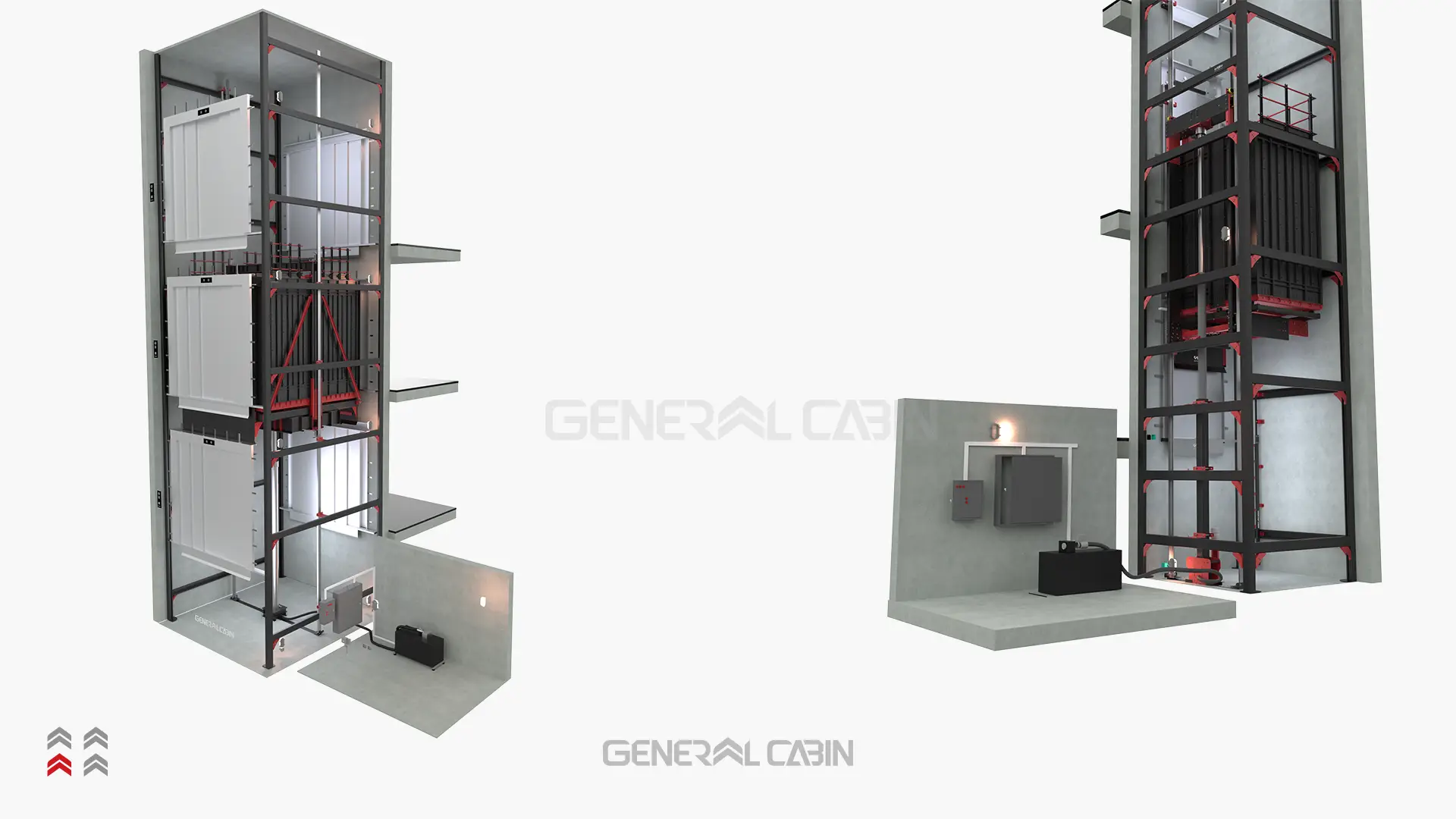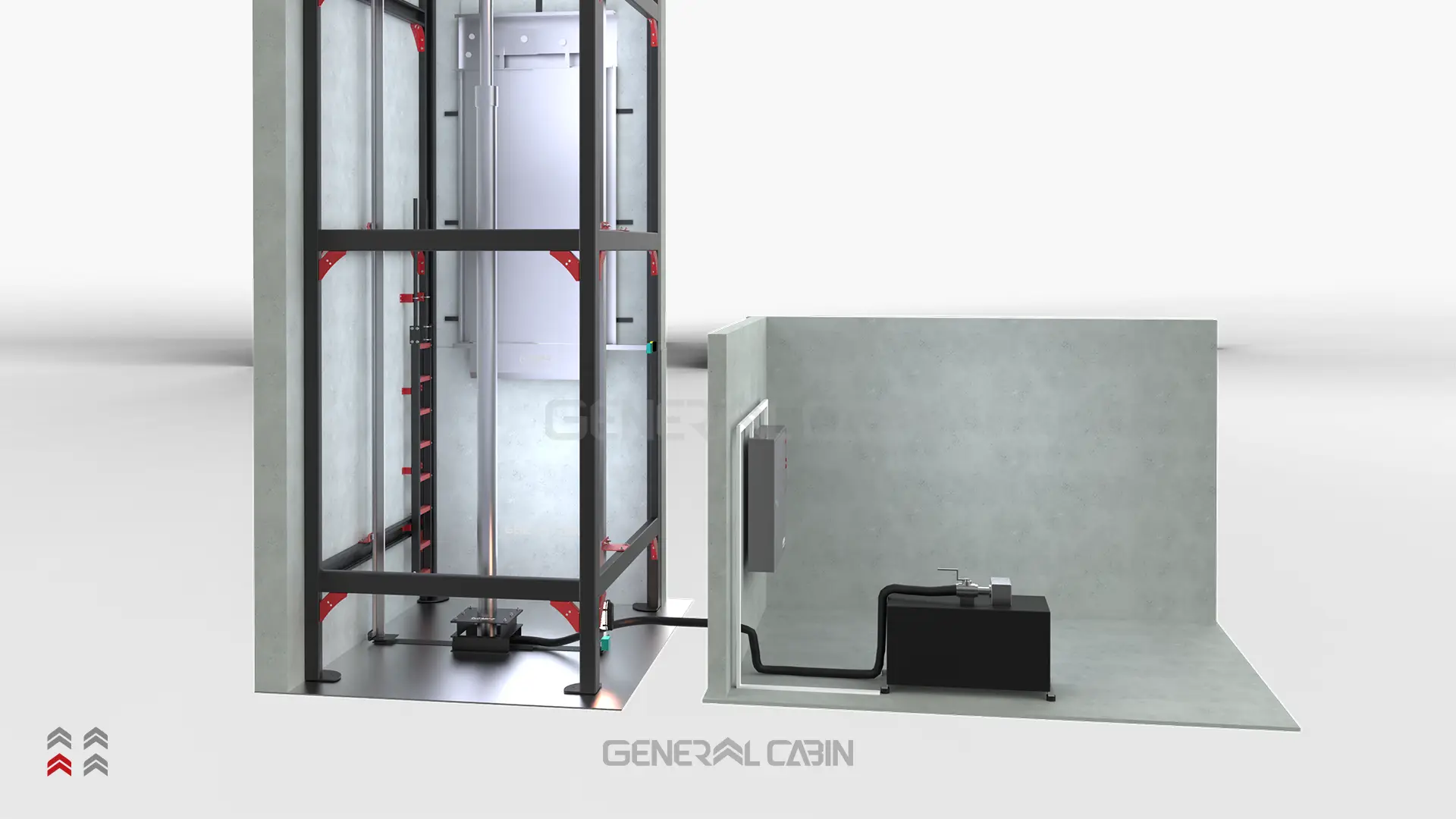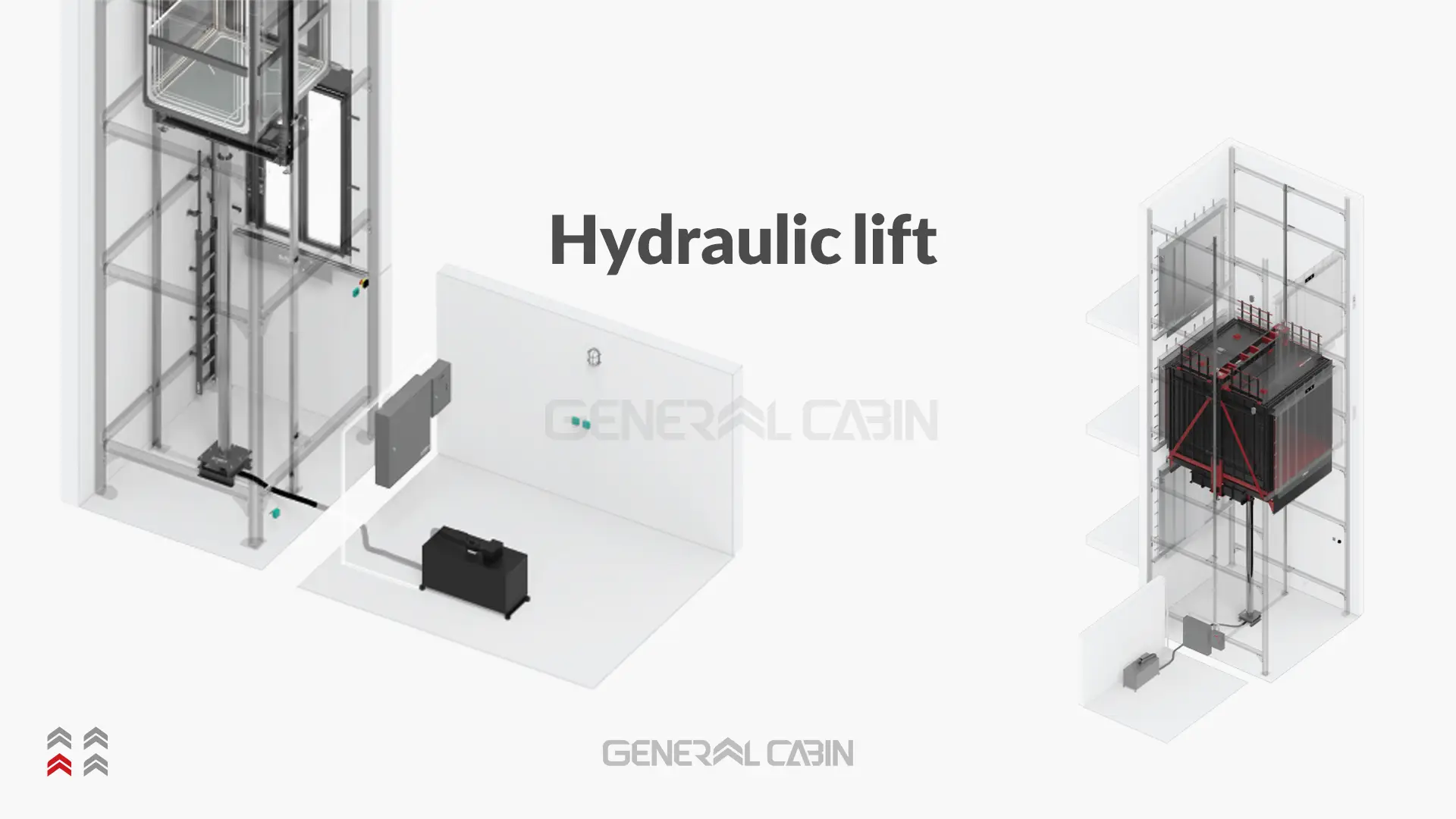
What is a Hydraulic Elevator?
Hydraulic elevators are among the most popular elevators operating through hydraulic pressure. They are widely used in residential and commercial buildings due to their high safety, easy installation, and low maintenance costs. This article comprehensively overviews hydraulic elevators, their types, and their components.
Hydraulic elevators move the elevator car using hydraulic pressure from oil or hydraulic fluid. These elevators include a power unit, jack, piston, and cylinder, working together to ensure smooth and seamless operation.
Hydraulic elevators are typically used in buildings with fewer than six floors. When the elevator ascends, the motor in the power unit starts, pumping oil from the tank into the cylinder. As the cylinder fills, the piston in the jack is pressurized and connected to the car sling, causing the elevator cabin to rise.
To stop the elevator cabin on each floor, the central system signals the motor to stop pumping oil. After the pumping stops, the elevator halts at the desired floor. To move the car downward, the system sends a signal to the control valves to open, allowing the oil to flow. This process causes gravity and the car’s weight to exert pressure on the cylinder and jack, emptying the oil cylinder.
For a complete stop, the central control system issues a command to close the valves, stopping the elevator car. This process ensures the elevator stops safely and accurately at each floor.
Comparison of Traction and Hydraulic Elevators
Speed: Traction elevators have higher speeds compared to hydraulic elevators.
Building Height: One of the crucial factors in choosing an elevator is the building height. Traction elevators are more commonly used in tall buildings, whereas hydraulic elevators are more suitable for shorter and less frequently used buildings.
Space Required for Installation: This is especially important for buildings with space constraints for elevator installation. Traction elevators require more space for installation compared to hydraulic elevators.
These are important factors in comparing the two types of elevators, and it is impossible to say one is better overall definitively. The appropriate choice depends on the building’s conditions, budget, and traffic needs.
An elevator consists of various electronic and mechanical components that work together harmoniously to form its performance. Understanding these components helps in using the elevator more efficiently and preventing breakdowns.
Types of Hydraulic Elevators
- Direct Hydraulic Elevator
Direct hydraulic elevators are one of the most commonly used types due to their simple design and high efficiency, suitable for medium-height buildings.
A direct hydraulic elevator connects the jack directly under the elevator car. Hydraulic pressure in the cylinder moves the jack, raising and lowering the elevator car.
Applications of Direct Hydraulic Elevators:
-Residential Buildings: Apartments, villas, and buildings with fewer floors.
– Commercial Buildings: Small shops, offices, and medium-height commercial centers.
– Industrial Centers: Transporting heavy loads in factories and warehouses.
Direct hydraulic elevators are an excellent choice for many medium-height residential and commercial buildings due to their simple design, high safety, and smooth movement.

2. Indirect Hydraulic Elevator
Indirect hydraulic elevators are advanced hydraulic elevators used in medium to taller buildings. This type uses a pulley and cable system to move the car indirectly.
In an indirect hydraulic elevator, the jack connects to a pulley and cable system, transferring hydraulic force indirectly to the car. The jack piston’s movement causes the cables to shift, moving the car.
Applications of Indirect Hydraulic Elevators:
– Tall Residential Buildings: Suitable for high-rise apartments and towers.
– Commercial and Office Buildings: Medium to tall offices and commercial centers.
– Industrial Centers: Transporting heavy loads in industrial buildings and warehouses.
Indirect hydraulic elevators are optimal for taller buildings due to their higher reach, smooth movement, and lack of a need for an overhead machine room.

3. Roped Hydraulic Elevator
Roped hydraulic elevators, also known as Machine Room Less (MRL), are advanced hydraulic elevators that do not require a separate machine room. Due to their high efficiency and space-saving design, they are suitable for buildings with limited space.
A roped hydraulic elevator uses a pulley and cable system alongside the hydraulic jack. Unlike traditional hydraulic elevators, these do not need a machine room at the top of the shaft, with equipment installed inside the shaft or a small nearby room.
Applications of Roped Hydraulic Elevators:
– Residential Buildings: Suitable for apartments and villas with medium floors.
– Commercial and Office Buildings: Offices and commercial centers with limited space.
– Industrial Centers: Transporting heavy loads in factories and warehouses.

Main Components of Hydraulic Elevators
Hydraulic elevators consist of various components that work together to ensure smooth and safe movement of the elevator car. Each component plays a crucial role in the overall performance of the elevator and must be regularly inspected and maintained to ensure optimal performance and safety.
- Power Unit
– Components: Motor, pump, oil tank.
– The power unit generates the hydraulic force needed to move the elevator. The motor drives the hydraulic pump, which pumps oil from the tank into the cylinder.
- Hydraulic Jack
– Components: Piston, cylinder.
– The hydraulic jack converts hydraulic force into mechanical force. The piston moves within the cylinder, raising and lowering the elevator car.
- Piston
– The piston moves under oil pressure within the cylinder and is connected to the car sling, moving the car as it moves.
- Cylinder
– The cylinder houses the piston. Under oil pressure, it moves the piston.

- Control Valve
– The control valve regulates oil flow into and out of the cylinder, controlling the elevator’s speed and direction.
- Oil Tank
– The oil tank stores the hydraulic oil used in the system. It must have enough capacity to store the required oil.
- Pulley and Cable System
– Used in indirect and roped hydraulic elevators to transfer the jack’s movement to the elevator car and increase the travel height.
- Central Control System
– Manages and coordinates the elevator’s components, issuing commands for the elevator’s movement and stopping.
- Safety Valve
– Prevents excessive pressure in the hydraulic system by stopping oil flow if overpressure occurs, preventing accidents.
- Car Sling
– The structure that holds the elevator car, connected to the piston or the pulley and cable system.
Hydraulic elevators, with their simple design and high reliability, remain one of the most popular elevators, ensuring smooth and safe movement of the elevator car. Regular inspection and maintenance of these components are essential to maintain optimal performance and safety.
Limitations of Hydraulic Elevators
- Due to the need for hydraulic elevators to transfer oil for movement, they are rarely used for speeds above 0.6 meters per second, as this would require a high-power motor and pump, which are naturally expensive.
- The performance of hydraulic elevators can sometimes fluctuate due to changes in oil temperature. In low-traffic hydraulic elevators, the oil temperature gradually decreases, while in high-traffic hydraulic elevators, the temperature increases. Therefore, it is necessary to control the temperature of the room where the power unit is installed to minimize temperature changes.
- The motor power required in hydraulic elevators is usually higher than that of traction elevators. Therefore, electrical cables suitable for the motor’s power must be used to prevent voltage drops. For this reason, a star-delta starter circuit is used to start the motor.
- Installation and maintenance costs are significant considerations in hydraulic systems. In the buried jack system, which requires deep pit drilling, there is an increased risk of encountering underground obstacles and additional costs for the buyer.
- Hydraulic elevators generate a lot of heat because all the energy used in lowering the elevator is converted to heat. If this heat exceeds the standard range, it can negatively affect the fluid composition and the proper functioning of mechanical components.
- In hydraulic systems with a buried jack, the high-pressure hydraulic system and related equipment are exposed to chemical, mechanical, and electrolytic attacks, which can weaken the cylinder walls and eventually cause leaks. One common preventive measure is using special coatings to separate the buried parts from direct contact with groundwater and soil.
- Limitation in supporting high speeds.
- Limitation in supporting great heights.


